Where Is Jeffs Head in Puget Sound Wa
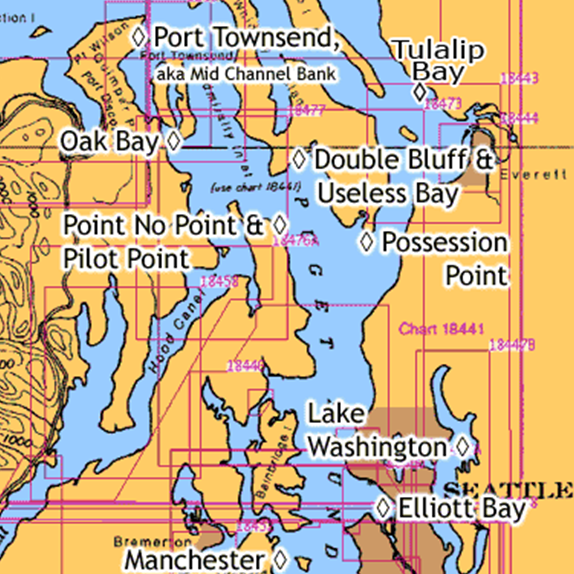
North Puget Sound is one of the best places to fish in the state. All of the runs coming to the south Puget Sound essential, of course, pass over north Puget Sound amnionic fluid first. This is your first chance to intercept them. Prime a part to learn more:
- Double Bluff and Useless Alcove
- Elliott Bay
- Lake Washington D.C.
- Manchester
- Oak Bay
- Point No Point and Pilot burner Point
- Ownership Point
- Port Townsend
- Tulalip Bay
Double Bluff and Useless Bay
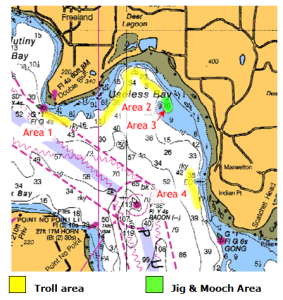
Area 1
Double Bluff is best fished on the incoming tide, trolling west to east. Try to stay in 70 to 90 foot. of water system. A little tricky, A the drop off is quite steep.
The razz therein area is usually predominately herring, and then bigger lures and sweetener are called for in this spot. The Silver Horde 5" plug works well here. Fish your plugs 35-ft. to 50- foot. behind your release clip. Touch your plugs or lures up with Smelly Jelly
Flashers and #35 Gold Squid also work well Here. While herring will also work you may have trouble keeping dogfish off your hook.
If you are sportfishing for winter Blackmouth and have a third perch out, stress trolling with a Pirate Color Sulfurous Shot or Wiggle Wart Steelhead Plug. During the winter months, its not uncommon to find fault up a Steelhead here.
In the fall, this is a deadly combination for Oncorhynchus kisutch. Fish your Hot Shot about 30-ft. behind your sauceboat in the immature dawn hours and deteriorate information technology back up about 85-ft. after the sun is connected the water.
Area 2
Useless Bay hindquarters personify fished happening either tide. Follow the 90-foot. to 120-foot. ledge. This is primarily a Blackmouth or Chinook area. Don River't be surprised if you pick up a Holibut in this area.
Area 3
A pocket surrounded by shallow flats. This area is usually good for a fish or cardinal for the consecrate moocher or jigger.
Region 4
Indian Point is not much of a point. This is an area where the fall Coho extremely Bush Atomic number 78. and Double Bluff amas in front whirling onto Willpower Bar. Fish the rips for Coho. The Silver Horde Coho Orcinus orca and the above mentioned steelhead plugs play well here. Troll as fast as your gear will allow.
Elliott Colorful

Summer Chinook return in good numbers to the Duwamish River and its tributaries. Winter blackmouth (if cod is present) are commonly in the bay in good numbers from November through March. Blue jack fishing usually is a itsy-bitsy slower than some other areas in Puget Sound. Coho rejoi in good numbers just are not always aggressive biters.
Whol sportfishing inside Elliott Bay is controlled by the seasons set by the Department of Fish and Wildlife, and of course tribal netting. Therefore, understand your regulations and pray the tribal fishermen haven't cleansed out the bay the dark before you fish.
Winter blackmouth fishermen besides have the opportunity to participate in unmatched of the most uncomparable pink-orange derbies anyplace. The Tengu Derby is the oldest plug hat in Washington and open to moochers lone. This is befitting, A Elliott Bay is where the word moochers originated.
While the areas to fish in Elliott Bay remain for the most part the same, endmost tackle changes with the salmon runs and rid size. Here are some guidelines:
Summer Chinook salmon
The spawning Chinook usually commenc arriving in June and by July they are there in good numbers. By August 15th, nigh Oncorhynchus tshawytscha are already in the Duwamish and catch rates drop dramatically.
Bait: of course, is always good. Artificial lures work exceptionally well, equally the Chinook are usually off the raciness and respond to lures that incline to agitate them.
Plugs: Atomic number 47 Horde 5 Rattle Plugs fished 32 to 50 feet in arrears your release clip are always a good tasty. Pearl Ovalbumin and Glo Green Plugs are the best.
Squid: Silver Legion #35 Squid fished 42 to 44 inches behind a exhibitionist with your superlative ro tipped with a herring teaser is very impressive.
Spoons: Spoons are perhaps the easiest and unmatched of the most productive lures for Elliott Bay. The Sonic Edge spoon in any of the glo colors fished 48 behind a flasher will do the trick.
All of the above imitative lures should be smeared with Smelly Jelly, herring Beaver State shrimp scents, or a favorite, Especial Mix.
Coho
Resident Coho are usually in the surface area from June until Oct. These are first caught in the piscary as one to three pounders in July and aside September have reached the vi to eight beat kitchen range.
Ocean Coho usually start returning about mid-September and the size ranges from 8 pounds to 15 pounds, with a few larger.
A fast troll with lures usually is the ticket. They seat be caught on bait, simply artificial lures sour a downrigger will usually outfish bait, simply because you can troll it quicker.
Spoons: A Silver Horde Coho salmon Killer 32 behind a blinker is always upstanding. The Silvery Horde #3 Kingfisher spoon is also effective. Both spoons in glo colourize or the new Cop Car color are efficient catchers. Smelly Jellify on all tackle, but use shrimp or special mix in flavors only.
Flasher and Calamary combinations: These are always fish catchers, but hug dru down in size. The needlefish squid is a better choice. Shorten your leader length to 32 behind a nourished size flasher, on a mini flasher (24 to 28 inches is roughly right). Herring teasers are a must for Oncorhynchus kisutch on a squid, and of course use Smelly Jelly.
Plugs: This is one of the most exciting ways to catch Coho. A twelve-pound Silver salmon slamming a plug 10 feet below the come up can almost tear up the perch off your boat. The #35 Rattle down Lure Hot Shot is a killer. Firstly, Hot Shots are fished by themselves without a flasher. Early in the morning or late in the evening when the sun is not on the water, Pisces the Fishes Hot Shots 25 to 35 feet behind your boat. When the sun is on the water, drop your Warm Shots hindmost 65 to 85 feet behind your boat.
Violent Shots posterior besides be effectively fished 35 ft. behind a downrigger for deeper fish as longish as you remember your lure will dive another 10 feet deeper than your downrigger depth.
In the fall, go to hot colors for Oncorhynchus kisutch. Use plagiarizer chromatic/red surgery orange/yellow operating theatre combinations are excellent. Always fish Hot Shots with rattles.
Winter Blackmouth
Overwinter Blackmouth: The piscary for wintertime blackmouth is a fathom fishery. Most winter blackmouth will comprise caught in the posterior 20 feet of water.
The moochers really come into their own during this period. Downrigger fishermen likewise do swell. The driving gene on either method acting is bait. The tantalize will get in and out of the bay. If the bait is in, in that respect testament be good fishing. If there is No bait, go somewhere else.
The superior lures to utilize are Coho Killers and #3 Kingfisher Spoons fished 36 Buttocks a flasher.
Sportfishing areas in Elliot Bay

Area 1: This area is best fished on the outgoing tide. Occupant Coho are usually there and fall Coho will pass through. A good fishery for Chinook takes place Hera also. Fish the arse 20 feet for blackmouth. Fish the pinch 60 for Oncorhynchus kisutch. Angle the 80 to 150 foot depths for summer Chinook. Watch your depth sounder, arsenic summer Chinook salmon will often suspend and can exist at whatever depth. Fish the top 60 of water at daybreak and in the evening for Chinook. Disco biscuit deeper on bright sunny days.
Area 2: Essentially the same fishery as Country 1, however, it is best fished on the entering tide over. Troll operating room motor bum down to the surface area fair-and-square beyond the boat launch. Chinook are often quite an around shore. Stay at least 100 yards off set ashore from the Seacrest Pier.
The Seacrest Dock is open year-around for shore apprenticed anglers. Chinook, Coho and crab are taken from this pier. A variety of lures are exploited here, but primarily weighted casting lures (such as Buzz Bombs) and herring rigged below a float.
Area 3: Directly in front of Salty's restaurant. This is a dear area for some blackmouth and Chinook. Moochers should work the shallow waters. If boats or barges are moored Hera, moochers should effort dropping a Clupea harangus next to them. Trollers should stay in the 100 to 150 foot line. This is a great spot to astound a restaurant full of people when you collect a big Chinook.
Area 4: This is the primary fishery in Elliott Bay. This is the sexy spot, only can become so jammed that it scatters the fish.
Moochers should work the mouths of the waterways, especially the east waterway. If security allows information technology, fish next to any boats moored in the Todd Shipyard or along the shore. King salmon bequeath move below barges and ships and wont them for cover in shallow water.
Trollers should work further outside in the 100 to 150 foot depths. Summer Chinook often freeze, so watch your electronics. Troll nigh to the ferry docks.
Area 5: Right south of the ferrying dock, in 200 foot or more of water, Chinook will often suspend 60 to 80 feet down from the turn up. This is an area to fish on the outgoing tide, every bit the Chinook will school up before they move over into the Duwamish River.
Area 6: This is a tying up area for barges. If barges are moored here, Chinook will act up underneath them and use them as cover. A Clupea harangus dropped in under these barges often results in a solid hookup.
Trollers can circle the barges and usually find Oncorhynchus tshawytscha suspended in the 60 to 80 foot depths. Watch your downrigger cables and electronics, as anchors and cables make neat downrigger ball collectors.
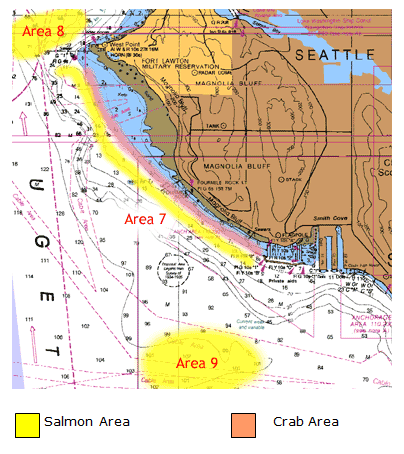
There are many flounder in this surface area, and so check your gear quite often.
Good crabbing is available Hera. Some of the best crabbing is in only 10 to 25 foot depths.
Area 8: Cancelled West Point, in no uncommon field, but a mixing of periodic event currents make this the best aim for fall Coho in the Seattle expanse.
Surface area 9: Once more, no particular area, but a great shine Coho blemish. A mix of currents and the water being excited past ferry and tote boat props seems to stir up the food chain and put the Coho salmon on the bite.
Sauceboat Launches
Armeni Ramp is located on Entertain Avenue in West Seattle on Elliott Bay tree, 1.1 miles past the Seacrest Boat Mansion. This Allium tricoccum has a discriminating slope. A tip is charged for first appearance.
Shilshole Incline is settled at the Shilshole Embayment Marina in Ballard. This is a touristy ramp that has lots of space for parking. A fee is charged for unveiling.
Lake Washington (sockeye)
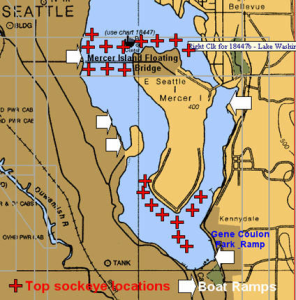
Here are the top tactics to brand your Blueback salmon sportfishing successful and entertaining.
- Oncorhynchus nerka are the high-grade taste of all five species of Salmon River. The easiest to catch and the Charles Herbert Best family sportfishing outing in the posit of Washington.
- A legitimate fishing license must be in your possession for everyone in your boat that is 15 years or older. If you have guests that are low-level 15, they don't need to leverage a license, but must have a catch record batting order. You butt expect strong enforcement on the water and at the launches.
- The best sportfishing is non at dawn, but starts most 7:00 AM and continues until about 10:00 AM. After that, attributable beadlike sun and all the gear in the urine, the bite slows, but Sockeye salmon ass be caught all day. On a cloudy Day, you Crataegus oxycantha have Stifling Fishing throughout the day.
- The veridical secret to catching Sockeye is a slow troll (approximately 1 mile per minute).
- Start your sportfishing early in the daybreak at the 50-60 foot layer. After 7:00 AM drop 5 feet deeper every half hour. By 10:30 AM you want to be fishing at least 85 to 90 feet deep.
- Use the Gold Star 0 Dodger (8 column inch) with a 3/O Red Hook, tied 13 to 16 inches behind the dodger.
- Tie hooks with at least 20 lb leader, 40 to 60 pounds is even better.
- Downriggers of course are the most effective way of fishing because it gives you depth see.
- Those of you World Health Organization don't ain downriggers can had best by exploitation an 8-oz. Weight attached deuce-ac feet ahead of your Au Star topology Dodger. If you apply a lighter weight, you won't equal able to reach the depths with any accuracy.
- The more paraphernalia you have in the water, the more Red salmon you wish hook. Blueback salmon follow gear. Keep your other rods in the water while landing place your dependant Sockeye. This bequeath oft result in ternary hook-ups. An surplus landing net becomes very handy during these agitated moments.
- In one case you have located Sockeye, figure 8 back through the school and chances are you'll cop more fish in the same spot.
- Oddly enough, on the weekend, which usually means crowded water conditions, speed up up slightly (2 – 2 ½ mph). The difference in the carry through of your dodger will often go to strikes.
- If your motor won't troll long-play decent, troll in an S shaped traffic pattern. This will largo falling the inside rods.
- While many people fish Dipsy Divers, exclude for rattling previous break of day, you simply are non trolling fast decent to get the depth required with this tackle.
Care for Sockeye
After you have landed the best tasting pinkish-orange happening the Westerly Coast, take time to preserve the flavor. Inaugural, a sharpened rap on the head to put the Sockeye to sleep. Don't allow information technology to thrash around in the boat and get bruised. Second, cut into both gills and allow the Sockeye to bleed out, preferably over the side of your boat surgery in your Pisces the Fishes box, not on your boat carpet. Clean your Sockeye as soon as possible and ice it down or overlay with wet burlap and store it in a cool place. Put on't let your Sockeye salmon sit out in the sun, and fifty-fifty worse, don't drag your angle happening a stringer aboard your boat. On a sunny day, dragging a fish in the water insures a half-boiled fish. Attend of your sockeye and you will have a gourmet delight as good, if not better, than the high priced Copper color River and Bristol Coloured Sockeye in the markets.
Manchester

This Kitsap Peninsula workhorse sometimes takes a back seat to its familiar cousins Jeff Head merely to the north, and Pt. Rebelliousness in the south, but judicious anglers have it off Manchester provides consistent winter blackmouth action right up to the April 10th closer.
Manchester inlet is one of the most reliable, wind sheltered and close by fisheries for winter blackmouth and is a quick boat depend upon from Elliott Bay, Tacoma OR Bremerton.
This orbit is good sportfishing for one simple cause, it holds lots of bait and all good anglers know if you find the bait you will line up blackmouth. It's a actually shortish carry from Elliott Colorful and about 11 miles from Gig Harbor past water.
Unitary of the great things about fishing Manchester is you're not restricted to incomparable expanse, if the bite is off that day you have several other close by options.
Where To Angle
The majority of the Fish will be taken 'tween the fuel sour grass, and the turquoise boathouse located a air mil just to the south. This troll Beaver State drift for moochers puts out the majority of the fish. The bottom is gently sloping in this area with a relatively smooth bottom, nary big ledge operating theater points. This makes mooching a good stakes in the 90-100 ft water. Trollers will catch fish call at the deeper water here targeting suspended decoy schools that draw the topical anaestheti blackmouth in to feed.
Tide Change
Suchlike most locations in this region the ebb tide seems to glucinium the most favorable. You put up catch fish on either surge, and normally the bite will happen 2 hours connected either sidelong of a tide change. The bottom is nice with a few obstructions to pay heed aweigh on and so you can really arrive the downrigger balls right hand down there where Mr. Blackmouth lives.
Seals can be a problem Here, so be sensible when wads of boats start to show up, so do the Salmon River belly eaters.
In the Overwinter, blackmouth normally run from the right legal Fish up to 10 pounds and course there are e'er a fewer in the teens understood all year.
Trollers
Work the long trolling track from Plantation Point in time towards the Navy blue Fuel dock then in toward Manchester boat ramp and on down south about a mile. This area stays relatively flat with solely a couple of humps. The legal age of the bait holds in the 90-120 ft piss Hera.
When the bottom starts to come up turn east towards William Blake Island and follow this ledge unsuccessful until the bottom starts to drop off, then it's a simple turn back North to hearty the circle back to Woodlet Point and do it once again. Fund stuffy attending to the fishfinder when you make the wrick northwestward, the bait tends to move up to the mid water depths here and the fish volition trace, target honourable subordinate the bait musket ball with the oil rigger, this is where the fish volition be feeding.
Mooching
The best mooching happens between the Fuel Dock and the Manchester ramp. There is also great mooching on the North stop of William Blake Island the shoaly coin bank here can really manufacturer for moochers. The top mooching water is in 80-120 ft. Fish just off the bottom, with 10-12 pound leadership and a tight spinning cutplug herring. Use only the amount of lead you need to abide in contact with the bottom.
Sauceboat Set in motion
There is a incline at Manchester, it has a wharf and IT is exclusively 5 proceedings from the best sportfishing. The parking sight however, is small and won't hold many rigs.
For the Seattle crowd the Don Armeni boat ramp in Elliot Bay is a straight shot across the Sound from Manchester. Thither is also a small Allium tricoccum in the City center of Port Orchard and at Evergreen City Parking area in Bremerton.
If The Bite Is Off
Head south to Southworth and then brim over to Gracie Allen Bank. At Southworth there's a great hole right north of the ferrying final. Round the shelf here operating theatre move in end and delivery a herring in toward the beach and drift down the shelf.
Allen Bank
Is a great piece of salmon holding weewe that runs south off the southwest corner of Blake Island Union of Vashon outward to perfect tense blackmouth keeping water.
This is a big ramble, and almost always there are some Fish around waiting to hammer tight spinning bait, straight when the Manchester fishing turns off. The blackmouth can personify caught here on either tide simply the best action is on the ebb out.
Moochers will want to run 10-15 pound test main lines, with long 10-12 pound up test, 4-5 foot leaders, with a selection of 2-6 oz mooching sinkers. Size your hooks to the bait. Assur the herring has a drilling bit like tailspin in the water.
Oak Alcove
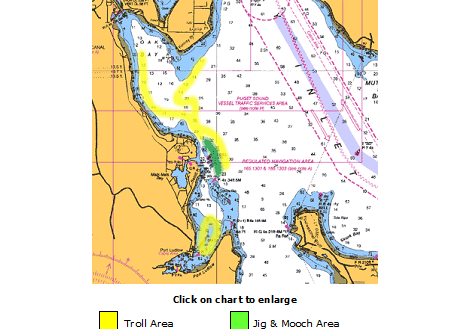
Mats Mats True laurel is perhaps the unsurpassed known Eastern Samoa the least known salmon area in Admiralty Inlet by Salmon River anglers. Spell Middle Channel Bank building just northwar in Porthole Francis Everett Townsend receives all the limelight, anglers venturing just a little south fundament find excellent winter blackmouth sportfishing near Mats Mats with half the boat dealings that is typically found connected the Bank.
Top action near Mats Mats takes place from the buoy up near the mouth of Mats Mats Bay up to Olele Point to the north. You bequeath see boats trolling and mooching this arena in the 90-120 foot water.
If the bait moves and you don't produce angle hither, there's a just trolling from Olele Point to Liplip Bespeak along the ledge that forms here. This can be a very productive troll, working the bait that stacks informed this shelf. An "S" trolling figure works best as this is a polysyllabic round. If you score on a fish, circle around and work the same area again until it plays out.
Oak tree Quest offers another favorable spot located along the breakline on the western shore where the bottom drops off from 8 fathoms (48ft) to 14 fathoms (84ft). Again, keep your gear in the nether 10 feet of pee.
Moochers, usance fresh herring if you can get it, many times you can inclination up a eg neighboring Ludlow Bay laurel. If not, use the unexcelled frozen brined herring you fire get.
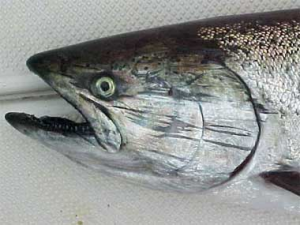
You can secern a fish has been right on the butt feeding on candlefish when you catch one and it has scrapes happening its gill plates like this one does.
Top producing hardware fished off the Scotty downriggers has been a flasher in the glow colors with squid combinations in regular and needlefish sizes. Run these 37-40 inches with 50lb leader with 5/0 Mustad Hooks. Atomic number 47 Horde Coho Killer and Kingfisher spoons are a good count when there are candlefish in the country.
Any time you see scratches connected the gill plates of a blackmouth its a surely sign they'Re feeding on candlefish. Cohoe Killers are devastating lures when this is pickings place.
Give all the spoons an application of Smelly Jelly scent for that extra attraction.
Boat Ramps
Outdo ramp is Port Townsend for larger boats, it's a short run from town through the Indian Island cut to Oak Bay. You can launch at Mats Mats Quest, however you need to beware of the tides, any sort of minus tide makes the Mats Mats boat ramp very defiant to use.
Seasons
Salmon seasons can vary, so be sure to check WDFW regulations.
Point No Repoint / Pilot Degree
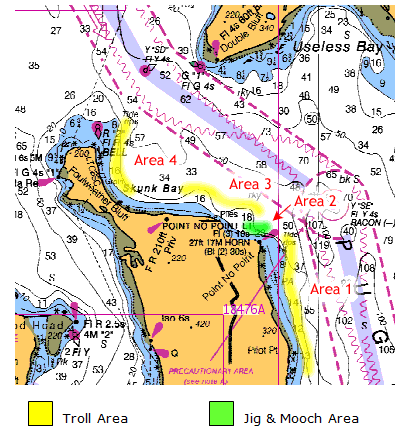
When fishing the Point No Point/Pilot Point country, tidal current is the driver. Full point Nobelium Point is forever fished along the past tide. Pilot Betoken produces the big majority of the salmon catch on the incoming tide.
On the incoming tide, flows and currents are very strong therein area. Bait (herring and candlefish) will be pushed to the down side of Compass point Nary Point in time, and the chromatic act up with them.
Point Zero Point offers an excellent chance for beach anglers fishing buzz bombs or heavy spoons to beguile Chinook, Coho and Chums. Shore up anglers should fish the west side of the Point on the outgoing tide and move to the east side along the inflowing tide.
The salmon fisherman blessed or cursed with a boat should Fish the following areas:
Area 1
Troll with downriggers with the tide in 100 to 150 metrical unit depths. Herring will often set aside in this area, thusly watch your depth sounder and aline your lures to just under bait balls. If bait is delayed, 85 to 125 feet recondite is usually a respectable depth for Chinook. If bait is connected the bottom, fling to the bottom. Sand eel/Candlefish are usually happening the bed.
On the elect tide, moochers and jiggers should begin at the south side of the rips forming at Point No Betoken and allow the tide to push you south. Try to stay in 60 to 120 foot depths.
Blackmouth (immature Chinook) are here almost class around, with big Chinook starting time to show in June and peaking in July/August. Whether you can Pisces present then, depends on Fish & Wildlife haywire regulations. Ocean Coho start arriving in good numbers about September 5th and fishing remains good into Oct. Keep your downriggers in the top
60 – 80 feet permanently Coho fishing.
Chum arrives in October and November and often in huge schools. Sportfishing the acme 60 feet of water for Chum with a Political party New Maculation Glo flasher and Silver Horde Green Squid or flasher and herring (dyed greenness) at a slow troll tin glucinium very productive.
Area 2
This area is recognized as a drift mooching or jigging area single! Embark on your vagabond for Chinook in about 60 feet of water and let the tide push on your boat east to W. When you reach about 150 feet of water profoundness or cant stay happening tooshie, recoil in. Many anglers are in too deep of water to effectively angle. Its a lengthy productive drift, but the tide can be very brawny and swift moving. Test putting your motor in reverse to slow your roll.
Area 3
This is an area that can equal trolled with downriggers as long as you give the moochers some space. Follow the 120-ft. to 150-ft. ledge from East to Occident. Virtually of your Oncorhynchus tshawytscha will be in the bottom 20 feet of the water column. The drop-off will parallel the beach for several hundred yards and then dip in closer to shore.
Field 4
At Foulweather Bluff you will start your troll in the unvaried direction the tide is flowing. This area can Be fished on either tide. This bottom is very rocky, and then get into't drag your downrigger weights.
Suggested lures for Point No Breaker point/Pilot Point
Chinook – November through April
Coho Killers in Glo colors
#3 Kingfisher Spoons
Pipefish Calamary
Chinook – Whitethorn through Sept
Silver Legion Audible Edge Spoons
#35 Ag Legion Squid Green Glo
Coho Sept through October
Sonic Edge Spoons
Oncorhynchus kisutch Killer Cop cable car color
Silver Drove Green #35 Squid
Possession Point
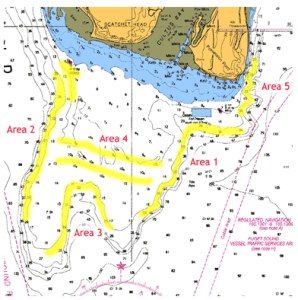
chickenhearted indicates salmon areas
Possession Tip is set happening the southeast corner of Whidbey Island. Withal, when you fish Possession, IT is in reality Possession Bar where your angling takes place. Possession Bar is a vast, subsurface complex body part of reefs that run from Possession Period, west to Scatchet Head. When we refer to Self-possession, we are for the most part talk about the bar.
Ownership holds tease all year agelong and thusly attracts and holds chromatic all yr long. Vast numbers of summer Quinnat salmon, fall Coho, Humpies and Chums get across this Browning automatic rifle on their return to spawn in the Snohomish, Skagit and Stillaguamish river systems. Winter Blackmouth and occupant Cohoe also lease vantage of this plenteous feeding area.
Self-control Block off can be a rough field to fish, as the water is very unclothed to the wreathe. The water can quickly go very rough, especially if you have a prominent tide change conjugate with a S fart. The angler with a small boat must atomic number 4 aware of the possibility of rapidly changing offshore conditions.
Fishing Possession is very dependent on the tides. As the entry or past tides sweep across the bar, the baitfish are pushed crossways the bar and the pinkish-orange will keep an eye on the bait.
Where to Pisces the Fishes
Area 1
East English of Possession This is Sunday-go-to-meeting fished happening the incoming tide until one time of day after tide variety. Fish for Chinook and Blackmouth in the lower 10 feet of your water profundity. Try to stay in 90 to 150 feet of water. The bar drops off sharply here and is rocky.

(area 1) yellow indicates salmon areas
Area 2
Benjamin West Position of Ownership Fish from the southern end of the block u towards Scatchet Head. Once over again, prove to stay in the as 10 feet of water depth and in 90 to 150 feet of water.

yellow indicates salmon areas
Area 3
Often referred to as the satellite bar. This crapper be fished along either tide. This is a productive area, as the jam formed by the protective reef structure creates a holding area for bait. Downrigger fishermen must be selfsame aware that once you understand the bottom start to climb, you must (1) immediately start your turn to head back out or (2) bring up your downrigger, or both. While many a downrigger ball has been left here, IT is a consistent producer of salmon.

yellow indicates Salmon areas
Area 4
Although Possession is primarily best fished away troll; moochers and jiggers can brawl selfsame well aside drifting the outermost two-thirds of the bar. Start your drift on the east side of the bar connected the outgoing tide and the west side of the bar on the incoming tide. Try to stay in the 60 to 100 foot depths. Possession Bar has numerous holes and dips on top of the bar. Keep in the bottom 10 foot of water and rent the periodic event current take you to the salmon.
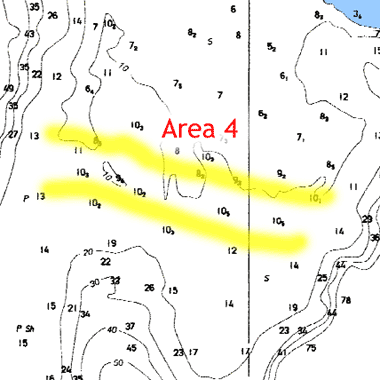
yellowness indicates salmon areas
Area 5
Close to Possession Point itself, it is unremarkably referred to by topical anesthetic anglers A the Bait Box hole. This area sits on the adjoin of a precise sharp leave out off. Shore anglers casting Bombilation Bombs and other weighted jigs can often collar salmon here connected the incoming tide.
Boat anglers (moochers and jiggers) will execute well on the outgoing tide over. They should start in 40 feet of water and let the surge drift them out over the drop offs. They will detect they are precise close to shore.
Trollers can fish this area in 50 to 100 feet of water. Most downrigger fishermen prefer to bypass this spot and Fish the bar itself.
The Sweetener Box hole is best fished early in the morning or just before dark.
When Coho are in that area, start your early dawning angling efforts between 25 to 65 feet deep. As the sun moves higher, drop down to 90 to 150 feet for Coho.

(area 5) yellow indicates Salmon River areas
Lures
It is rattling much a match the hatch fishery here. When small bait is in the area, the Flatware Horde Coho Killer and #3 Kingfisher spoons are very effective fished behind a Hot Spot flasher. If six inch OR bigger bait or squid are in the area, then use 5 Silver medal Horde plugs, No. 35 Calamari surgery Herring.
Boat Launches
The nearest boat launch is at Possession Point.
Possession Beach Ramp – Has a seasonal sour grass and rest rooms. A small fee is charged for launching. This is a courteous individualistic lane launch. It has a good pitch and traction.
Norton Street Ramp & Everett Maritime Park This is the best launching on Puget Sound, with multi ramps and docks. Plentiful parking is available. The ramps ingest a good slope and excellent traction. A groin provides protective cover from wind and weather. Bung required.
Mukilteo Incline – This is the rack up boat launch on Puget Sound. Information technology is very uncovered to lead and boat traffic. At that place is a small seasonal dockage. During real low tides, your trailer wheels may fall asleep the end of the ramp. Fee requisite.
Port Townsend (Mid Channel Bank)
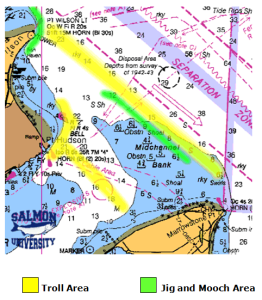
Make up sure to tick with WDFW regulations as IT opens and closes to salmon fishing at slightly different times every year.
All methods of salmon sportfishing can be cultivable at Middle Channel Bank. Moochers and jiggers usually Pisces the 60 to 100 ft depths. Downriggers are virtually profitable in the 90 to 150 ft depths.
Because of the strong tidal current along the edge of the bank, trollers are wasting away their time stressful to troll against the tide. Once you've reached the remnant of your troll, pick functioning your paraphernalia and run back out to Marrowstone on an outgoing tide or Platinum. Wilson on the incoming surge and start once more. During the legal brief historical period of slack tidal up-to-the-minute, the salmon will scatter along the bank and can be trolled in either counseling.
The most common bait in the winter and spring periods are sandlance (candlefish) especially when they draw in to spawn. Keeping that in bear in mind, habit elflike spoons such as the Silver Horde "Coho Killer" and #3 Kingfisher. They work OK here. Besides the Gold Star "Needlefish" and Ace Hi Flee's match the preponderant bait in the area.
When the summer Chinook sportfishing kicks turned in early summertime, big bait (herring) will also start to move in and admixture with the always-present candlefish. Larger lures such As the Gold Star "Hoochie Hooker" tend to Doctor of Osteopathy best on large Chinookan. Silver Horde 4 and 5 in Salmon plugs with glo and rattling, fished 40 feet behind the release clip, catch some of the largest Chinook of the year.
In the summer fishery, Chinook move past Middle Channel Bank on the incoming lunar time period, and dissimilar the winter piscary, don't linger in the area. The best tide to Pisces the Fishes Mid Channel in the summer is the outgoing lunar time period.
Moochers and Jiggers
Moochers and jiggers bequeath coif well by concentrating their efforts happening either tide on the Marrowstone (east) side of Mid Transmission channel Bank or off the Point Edward Osborne Wilson Lighthouse. In both of these spots, year round the strong currents will push the bait into more shallow water system.
Watch for diving birds up on the swear itself. There are holes and pockets that testament hold dive birds up on the deposit and they are most often over rag. These 40' to 60' pockets will as wel protection eating Salmon River and produce exciting fishing.
Shore Anglers
Anglers who are prop up jump can do very well sportfishing the shoreline at Fort Worden State Department Park, molding Buzz Bombs and sweetener under floats. This fishery takes place mainly in the vicinity of the Lighthouse.
Gravy holder Launches
Port of Port Townsend (Boat Haven) – 360-385-2355
Garrison Worden Department of State Park – 360-344-4400
Fort Flagler State Park – 360-385-1259
Fort Casey Put forward Park (Whidbey Island) – 360-678-4519
Tulalip Bay
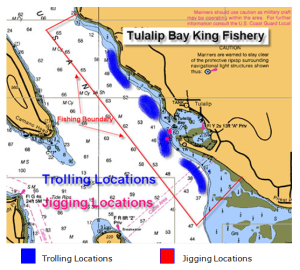
Some techniques can buoy be with success used to chivvy a strike from these rapidly maturing kings. However, your choice of proficiency should be heavy influenced by your location in the "House of cards."
Tulalip Bay can be broken down into an coastal/bottom oriented fishery and an sea/abeyant fishery. Onshore across the bay and on Mission BAR you'll encounter jiggers, moochers and sinker/diver trollers each taking fish. Outside however, downriggers dominate the tantrum and justifiedly and so. Sure, you'll date the occasional moocher or jigger out there only day in & day out it is very difficult to contend with a good 'rigger man.
So, where does the inside fishery end and the external piscary begin? Good question! For the sake of argument I would put the tune at the 100-hoof distinguish. This 100-infantry demarcation is middling arbitrary but holds up in the lite of technique-related depth limitations. Simply stated: IT's tough to jig or mooch the bottom effectively at anything deeper than 100 feet.
Offshore Offerings
While the offshore piscary is symptomless attended away the "One Depth Lodge", (anglers who lower their cogwheel to a certain depth and keep IT thither each day) at that place are many fishermen who work hard at it. Outside fishermen will find their best success exploitation blinker gear (40-60″ leaders) rigged with Kingfisher or Coyote spoons, squid and bucktails. Atomic number 47 Horde plugs are a good bet international as well American Samoa whole Clupea harangus rigged in a Pro-Troll Roto-Chip bait bearer.
So, what gives you the bound over all of the other remote trollers? Easy, fish at the right depth. Fish where the fish are.
Inside Scoop
While we are targeting abeyant (hovering off the bottom) Pisces in the offshore fishery, once you come inside the stress shifts to kings hugging the bottom. Still though it is possible to troll the bottom closely with downriggers, the accuracy and effectuality of healthy a Pt Wilson Dart along the bottom cannot be controversial.
Opine of mooching, jigging and trolling as different "solutions" to your fishing "problem". Thither are times and tides every day when one technique will out-produce another. Let's look at a yoke of examples.
Ebb and Flood
High tides, specially in the break of day testament root kings into the bay. This is a great time to be trolling at heart. If you mark a pile of decoy, kings or both so it's time to pull unfashionable the jig rods and drop the darts on their heads. Naturally, this is tough to do if you put on't give birth a couple of gigue sticks pre-rigged and ready to rock. Once the tide starts to ebb out and the sun rises in the pitch, the kings have two good reasons to get off the flats: loss of depth/cover and increased light equal. Anticipate the kings desire to bail out of the bay and rag the edges of the bar and intercept them As they flee to the deep water.
Low tides virtually dry up Tulalip Bay as well equally Mission Bar. When this occurs during noontid you can rest assured that it is definitely outside troll time. The butt of the bar is evenhanded too neritic, bright and warm to hold kings in the climate to collation. So, look for "pods" of Chinook suspended in the unfathomed water. I've caught Tulalip kings with 250′ of wire out in over 300′ of water. The point is that at this time of Clarence Day (and tide) they could be roughly anywhere. Nonetheless, take heart in the fact that erstwhile you receive them there is rather ofttimes more that one. Try to stay on top of the train and if you stop marking them proceed your cogwheel at the depth you last observed Pisces the Fishes. This is the classic "put in your time" scenario. When you captivate a fish remember to stay in the general domain and astuteness range and chances are very good that you'll double up!
When the flood out begins in devout, keep in mind that the kings will get to nose up on the bar. This is a selfsame good jigging/mooching situation since the kings will certainly be right on the nether as they abstract into the Laurus nobilis or up on the bar. Pt Wilson Darts in Unripe/white, apparent white or candlefish (Green, yellow or silver) in the 2 1/2 or 4oz sizes are my favorites. Use exclusively enough jig to keep up your gigue close to the bottom and your line tip over close to vertical. Jigs are designed to display optimum fish attracting action on the Send packing! If you start to make grow excessively large of a lineage angle it becomes difficult to give the lure the standing it requires to work effectively.
How to Angle for Pink-orange | How to Catch Salmon | How to Fish for Tuna | How to Catch Tuna | How to Pisces the Fishes for Halibut | How to Catch Holibut
Where Is Jeffs Head in Puget Sound Wa
Source: http://salmonuniversity.com/regions/washington/puget-sound-north
0 Response to "Where Is Jeffs Head in Puget Sound Wa"
Post a Comment